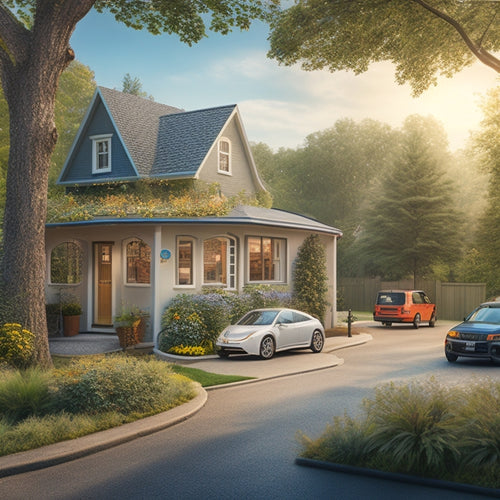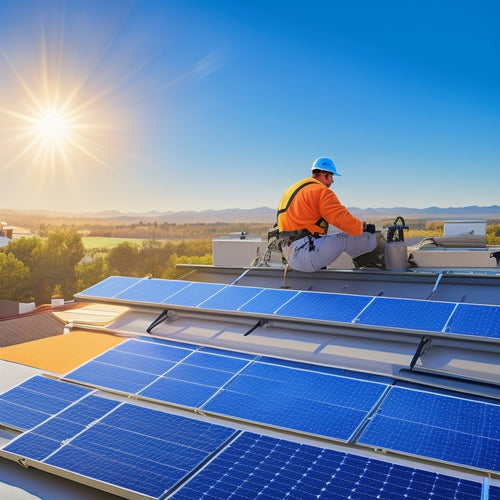
How Does a Small Off-Grid Solar System Work
Share
You can power your home with a reliable and sustainable energy source, thanks to small off-grid solar systems that convert sunlight into electrical energy. Solar panels, like monocrystalline ones, generate up to 22% efficiency. Charge controllers regulate energy flow to your deep-cycle batteries, which store excess energy for nighttime or cloudy days. Inverters convert DC power to AC for home use, with high efficiency maximizing energy harvest. System monitoring tracks performance, and load calculation guarantees appliances receive a consistent energy flow. By understanding these components, you'll be one step closer to achieving energy independence - and there's more to investigate in making this system work seamlessly for you.
Key Takeaways
- A small off-grid solar system generates energy through solar panels, which convert photons into electrical energy via photovoltaics (PV).
- The system stores excess energy in deep-cycle batteries for nighttime or cloudy day use, providing a steady flow of energy.
- A charge controller regulates energy flow from solar panels to batteries, preventing overcharging and undercharging, and extending battery lifespan.
- An inverter converts DC power from batteries to AC power for home use, with high inverter efficiency ensuring minimal energy loss.
- The system is monitored and optimized through real-time data logging, enabling identification of potential issues early and enhancing maintenance and troubleshooting.
Solar Panel Energy Generation
Utilizing sunlight, solar panels convert photons into electrical energy through a process known as photovoltaics (PV).
You'll find that there are several solar panel types, each with its own energy efficiency rating. Monocrystalline silicon panels, for instance, boast high efficiency rates of up to 22%. Polycrystalline silicon panels, on the other hand, have slightly lower efficiency rates but are more cost-effective. Thin-film panels, while less efficient, are flexible and suitable for curved surfaces.
When selecting solar panels, consider factors like energy efficiency, durability, and warranty. High-efficiency panels may be more expensive, but they'll generate more power per hour of sunlight.
Look for panels with high fill factors, which indicate better energy conversion rates. Additionally, verify your panels are certified by reputable organizations like UL (Underwriters Laboratories) or IEC (International Electrotechnical Commission).
Charge Controller Functionality
Frequently, an essential component in an off-grid solar system is overlooked: the charge controller. Your charge controller plays a crucial role in regulating the energy flow from your solar panels to your batteries. Its primary function is to prevent overcharging or undercharging of your batteries, which can greatly reduce their lifespan.
The charge controller's functionality can be broken down into three primary charge types:
| Charge Type | Description | Controller Features |
|---|---|---|
| Bulk Charge | Charging the battery from a low state of charge to a high state of charge | Maximum power point tracking (MPPT) |
| Absorption Charge | Topping off the battery to guarantee it's fully charged | Constant voltage regulation |
| Float Charge | Maintaining the battery at a fully charged state | Trickle charging, battery monitoring |
You'll want to look for a charge controller that offers features like MPPT, overcharge protection, and short-circuit protection to guarantee your system operates efficiently and safely. By choosing the right charge controller, you'll be able to maximize your energy harvest and extend the life of your batteries.
Battery Storage Systems
In a typical off-grid solar system, one or more deep-cycle batteries serve as the heart of the battery storage system, storing excess energy generated by your solar panels during the day for use at night or on cloudy days.
These batteries are designed to provide a steady flow of energy over a long period, making them ideal for off-grid systems.
When it comes to choosing the right battery for your system, you'll need to take into account factors like capacity, voltage, and type.
There are several types of batteries to choose from, including lead-acid, lithium-ion, and nickel-cadmium. Each has its own advantages and disadvantages, so it's crucial to select the one that best fits your needs.
Here are some key things to keep in mind when it comes to battery storage systems:
- Regularly check and maintain the electrolyte levels in your batteries to make sure they're operating at peak efficiency.
- Keep your batteries in a cool, dry place to prolong their lifespan.
- Think about investing in a battery monitoring system to keep track of your energy usage and storage levels.
- Always follow the manufacturer's instructions for charging and maintenance to get the most out of your batteries.
Inverter Conversion Process
Your off-grid solar system's battery storage system is only half the equation. The other half is the inverter conversion process, which converts the DC power stored in your batteries to AC power that your home can use.
There are several types of inverters, including string inverters, microinverters, and power optimizers. Each has its own advantages and disadvantages, but they all serve the same purpose: to convert DC power to AC power efficiently.
When choosing an inverter, inverter efficiency is a vital factor to take into account. Look for an inverter with a high efficiency rating, usually above 95%. This guarantees that most of the energy stored in your batteries is converted to usable AC power.
A high-efficiency inverter also reduces heat generation, which can prolong its lifespan.
In the inverter conversion process, the DC power from your batteries is fed into the inverter, which then converts it to AC power through a process called pulse-width modulation.
The AC power is then sent to your home's electrical panel, where it can power your appliances and lights.
With a reliable inverter conversion process, you can enjoy a steady supply of power from your off-grid solar system.
System Monitoring and Tracking
Three key metrics - voltage, current, and temperature - are essential to monitoring and tracking your off-grid solar system's performance. You need to keep a close eye on these metrics to guarantee your system is running efficiently and effectively. This is where system monitoring and tracking come in.
Monitoring your system's performance allows you to identify potential issues before they become major problems. You can track your system's performance using a monitoring system that provides real-time data on your system's voltage, current, and temperature. This data is vital for performance analysis, helping you to optimize your system's performance and make data-driven decisions.
Some key features to look for in a monitoring system include:
- Real-time data logging for performance analysis
- Alerts and notifications for system faults or errors
- Remote monitoring capabilities for convenient system checks
- Integration with your system's inverter and other components for seamless data tracking
Load Calculation and Sizing
Across your off-grid solar system, various appliances and devices rely on a consistent flow of energy to function properly, and it's essential that your system is sized appropriately to meet their combined load.
To achieve this, you'll need to calculate your total load, taking into account both the types of appliances you'll be powering and their individual energy efficiency. There are two primary load types to examine: AC and DC. AC loads include devices that require alternating current, like refrigerators and laptops, while DC loads require direct current, such as lights and fans.
When calculating your total load, you'll want to account for the wattage and voltage requirements of each appliance, as well as their usage patterns. For example, if you have a 100W refrigerator that runs for 8 hours a day, you'll need to factor in 800Wh of daily energy consumption.
Mounting and Installation Options
As you prepare to deploy your off-grid solar system, the mounting and installation process requires careful consideration to guarantee ideal energy harvesting and system longevity. The goal is to make certain your system operates efficiently, withstands environmental conditions, and meets local regulations.
When selecting a mounting option, consider the following:
-
Ground Mounting: Ideal for open spaces, this option allows for easy maintenance and flexible orientation angles.
-
Roof Mounting: Suitable for existing structures, roof mounting is a popular choice for residential installations, offering a sleek, low-profile design.
-
Pole Mounting: Elevating your solar array on a pole provides better airflow, reduced shading, and improved structural integrity.
- Portable Systems: Designed for temporary or mobile installations, portable systems offer versatility and ease of relocation.
Before installation, make certain you've obtained necessary permits and conducted a thorough site assessment, considering factors like weather considerations, orientation angles, and aesthetic options.
A well-planned installation will translate to peak system performance and a longer lifespan for your off-grid solar system.
Grid Independence Benefits
By going off-grid with a small solar system, you'll gain energy security now, ensuring a reliable supply of power even during grid outages.
You'll also greatly reduce your utility bills, as you'll be generating your own clean energy.
This independence from the grid will bring you peace of mind and substantial cost savings over time.
Energy Security Now
Embracing grid independence with a small off-grid solar system enables you to take control of your energy security, freeing you from the uncertainties of the traditional grid.
You'll no longer be at the mercy of power outages, rate hikes, or infrastructure failures. With a small off-grid solar system, you'll have the power to generate your own clean energy, reducing your reliance on the grid and increasing your energy independence.
Some benefits of energy security with a small off-grid solar system include:
-
Uninterrupted power supply: With a battery backup system, you'll have a reliable source of power even during grid outages or natural disasters.
-
Reduced vulnerability to price volatility: You'll be shielded from rising electricity rates and price fluctuations, giving you more control over your energy expenses.
-
Increased energy autonomy: You'll be able to generate your own clean energy, reducing your carbon footprint and contributing to a sustainable lifestyle.
- Enhanced energy resilience: You'll be better prepared to handle unexpected events, such as natural disasters or grid failures, with a reliable source of power.
Reduced Utility Bills
With a small off-grid solar system, you're no longer bound to the grid's meter-ticking rhythm, and your utility bills begin to dwindle. This is because you're utilizing renewable energy from the sun, reducing your reliance on traditional fossil fuels. As a result, you can enjoy significant cost savings, which can add up over time.
| Benefit | Description |
|---|---|
| Energy Efficiency | Reduced energy consumption through sustainable living |
| Cost Savings | Lower utility bills through renewable energy generation |
| Environmental Impact | Reduced carbon footprint from fossil fuel usage |
| Government Incentives | Tax credits and rebates for DIY installation and maintenance |
| Increased Property Value | Enhanced property value through off-grid capabilities |
Frequently Asked Questions
Can I Use Off-Grid Solar With Existing Electrical Infrastructure?
You can integrate off-grid solar with existing electrical infrastructure, leveraging off-grid benefits like electricity independence, while still utilizing the grid as a backup, allowing you to optimize your energy usage and reduce reliance on public utilities.
Are Off-Grid Solar Systems Compatible With Generators?
You can integrate off-grid solar with generators through hybrid systems, allowing you to utilize solar energy during the day and switch to generator power at night or during periods of low sunlight, ensuring a reliable energy supply.
How Often Should I Clean My Off-Grid Solar Panels?
As you bask in the freedom of off-grid living, don't let dust and dirt dim your solar sparkle! You should clean your panels every 6-12 months, depending on climate and debris, to maintain peak panel performance and maximize energy harvest.
Can I Add More Solar Panels to My Existing System?
You can expand your solar panel array, but first, assess your system capacity to guarantee it can handle the added power; consider your charge controller, inverter, and battery bank's limitations before undertaking solar panel expansion.
Will My Off-Grid Solar System Work During a Power Outage?
You'll be glad to know that your off-grid solar system will work during a power outage, thanks to its independence from the grid, maximizing off-grid benefits and solar efficiency, ensuring you've got reliable power when you need it most.
Related Posts
-

Why Nearby EV Conversion Shops Matter to You
Having a nearby EV conversion shop means you'll experience the benefits of a more personalized, convenient, and susta...
-

Safely Staying on Course: 5 Essential Lane Tips
You're about to take your driving skills to the next level by mastering the art of staying in your lane. First, inves...
-

3 Essential Steps for Solar Electricity Installation
To guarantee a successful solar electricity installation, you'll need to follow three essential steps. First, assess ...


